This post may contain affiliate links. Please read our disclosure policy.
Learn how to make this Vietnamese New Year/Tet staple known as Banh Tet. The cake is made with glutinous rice flavored with pandan leaves and filled with mung bean paste and pork filling and wrapped in banana leaves. I’m also sharing how to make banh tet without the complicated wrapping and tying.
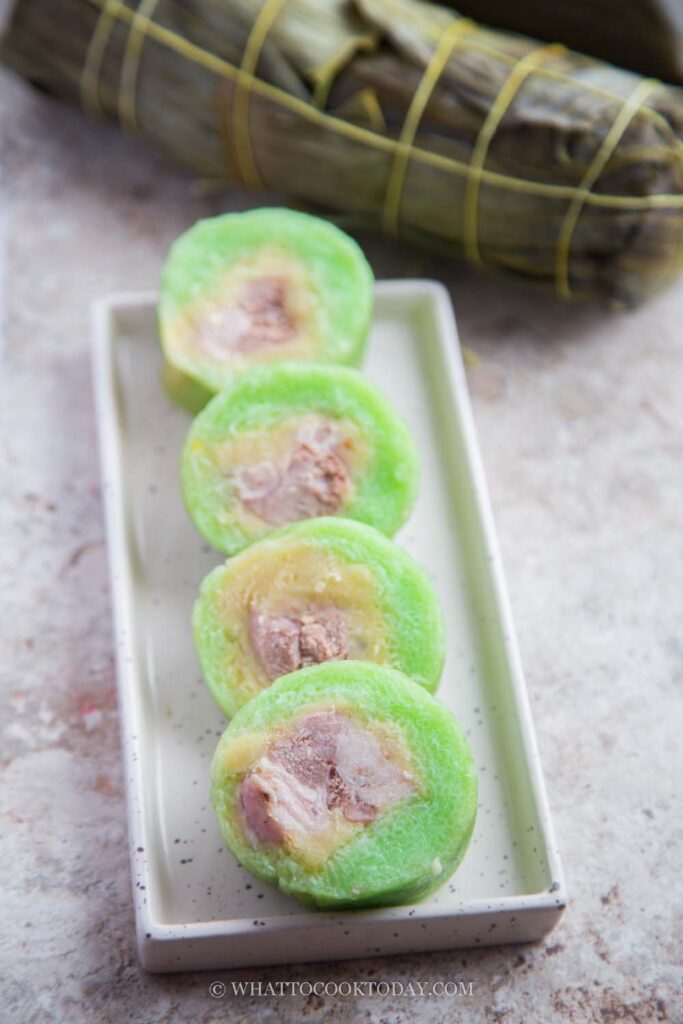
I had eaten many banh tet during my college years. I always get one from the Vietnamese store when I happened to do a grocery there. I had never tried to make some myself until few months ago when I started to experiment with making banh tet.
What is Banh Tet?
Banh can refer to cake, pies, bread, crepes, fritters, noodles, and a wide variety of food. Tet means festival but usually refers to the Vietnamese Lunar New Year, which is the same day as the Chinese Lunar New Year. Banh tet is made to celebrate the Vietnamese Lunar New Year and usually eaten on the first day of Tet. Banh tet is made with glutinous rice with mung bean and pork filling on the inside. The cake is wrapped in banana leaves in a log shape and secured with strings. The cake is then boiled for hours and then cooled down before being served. The cake is then cut into round slices
Why you’ll like this recipe
1. Banh Tet is cooked in Instant Pot pressure cooker, which is convenient and saves some time
Cooking on the stove may take 3-4 hours of boiling and constant monitoring of the water so it won’t run dry. By using Instant Pot, it cuts down on cooking time by half and you don’t have to worry that the water will run dry
2. You don’t have to use a lot of banana leaves, which can be expensive if you live outside of Asia.
Traditionally, one roll needs 4-5 sheets of banana leaves to wrap. In this tutorial, I’m showing you how to wrap with just one banana leaves and then the rest of the layers can be done with aluminum foil, which is so much easier and economical, yet effective

Main ingredients you need to make Banh Tet
1. Glutinous rice
Also known as sweet rice or sticky rice. It is not the same as sushi rice. Glutinous rice is really sticky and chewy and it is naturally gluten-free. There is no gluten in it despite the name glutinous, which refers to the sticky nature
2. Pork
A pork belly is usually used. You can also use pork butt/shoulder, which has a nice mixture of meat and fat and is not as greasy as pork belly
3. Split yellow mung beans
This can be easily found in any Asian grocery store. As they have been split, they don’t take long to cook
How to make Banh Tet using Instant Pot
1. Cut the meat into about 6 inches (15 cm) long strips. Add salt, sugar, and pepper and mix to make sure the meat are evenly marinated. I cover and leave this overnight in the fridge
2. Soak the rice in pandan juice for at least 4 hours or overnight. Drain off the liquid after that and add 1 tsp of salt and toss to combine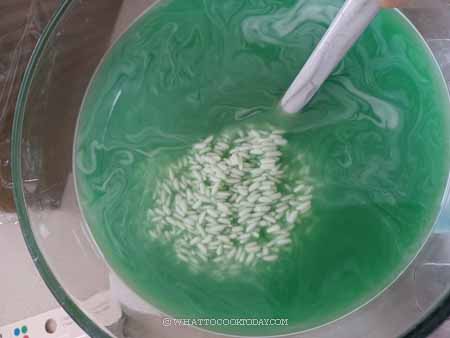
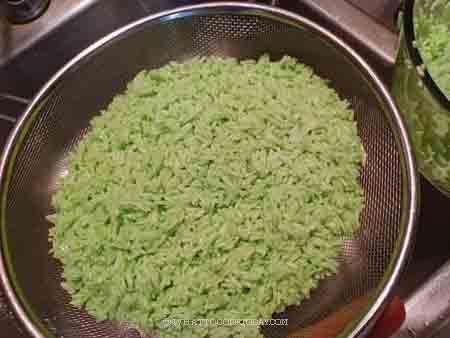
3. Rinse the mung beans in clean water and then drain off water. Put mung beans with water in a pot and bring to a boil and then lower the heat to let it simmer until the beans are soft and water is reduced, about 20 minutes or so. You should be able to easily mash the beans. Add salt and sugar and mash the beans with a spoon. The mung beans may appear soft now, but it will harden later. Let it cool down completely at room temperature. If you are making this the day before, cover and store in the fridge
4. For each log you will need one banana leaf about 10 x 10 inches (25 x 25 cm) and 2 pieces of aluminum foil, the same size. The banana leaf will impart a nice flavor to the sticky rice and the foils are to secure the log so the rice won’t leak out during cooking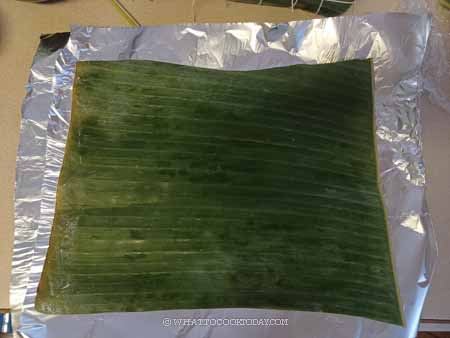
5. Spread the mung bean paste on a cling wrap, about 6 inches in width. Place 50 grams of meat. Pull the cling wrap up to enclose the meat. Mold the bean paste around the meat to secure it into a log shape. Repeat with the rest of the meat and mung bean paste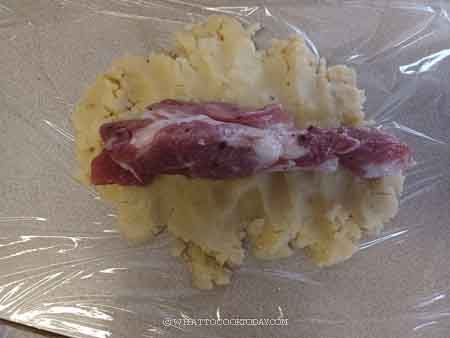
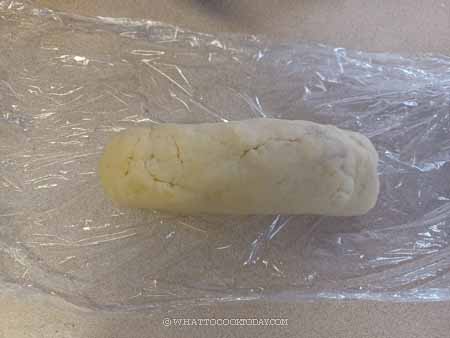
6. Option 1: Wrapping (with banana leaves + aluminum foil):
Place two sheets of banana leaves on top of each other, shiny side facing down. Then the third banana leaf on top, shiny side facing you. 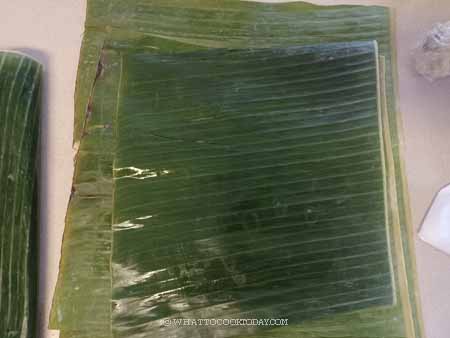
7. Spread half of the rice on the banana leaf. Place one filling in the middle. 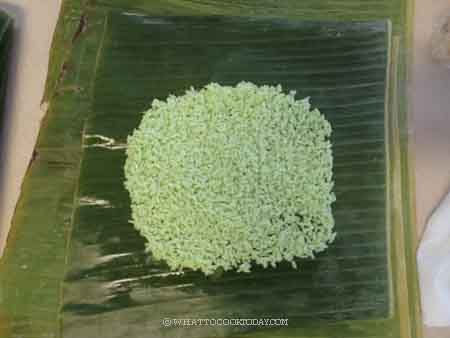
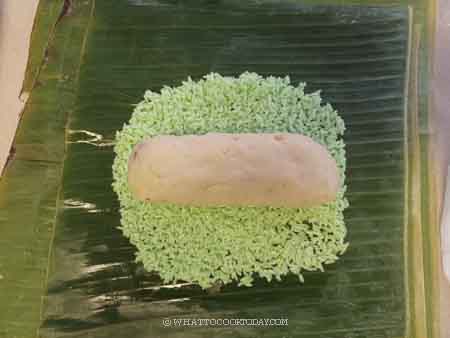
8. Top with more rice on top of the filling log. Leave about 2 tablespoons of rice to top up on each side later
9. Lift up the banana leaf on both sides and then fold it over to enclose it. 
10. Roll it together with the other two banana leaves to form a log. 

11. Bent the extra leaves at the bottom as you position the log straight up. 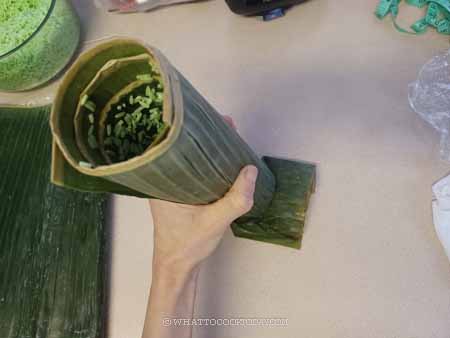
12. Use one rubber band to secure the lower bottom. Fill up with one tablespoon of rice.
13. Fold the leaves over to secure. 

14. Cover with the long banana leaves ( 8 x 20 cm). Secure with a rubber band. Repeat with the other side.
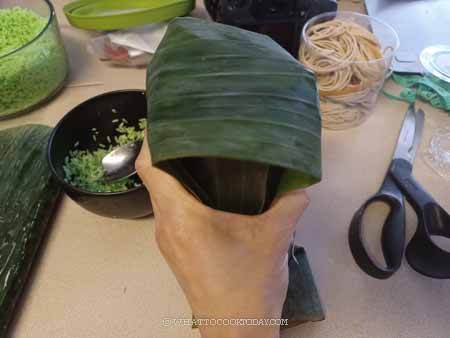


15. Remove the rubber bands and use a long kitchen string, three times the length of the banh tet to tie the log vertically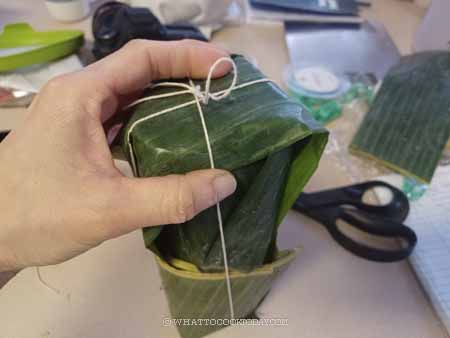
16. Then use shorter strings to tie around the log to secure it so the leaves won’t burst open during cooking. My wrapping and tying are not the most professional looking lol, but it works to secure the log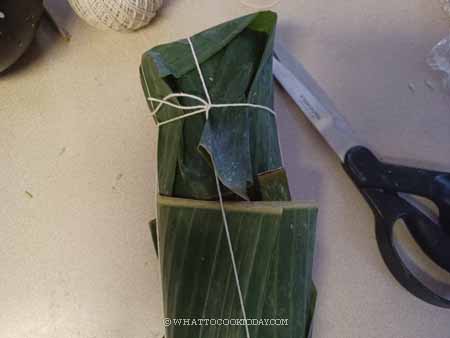
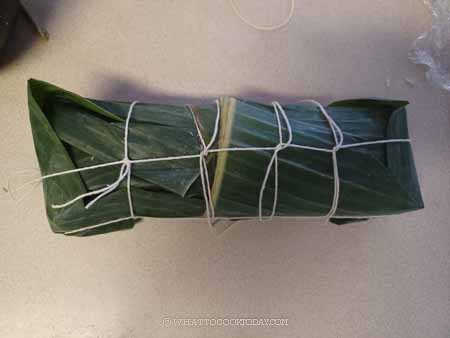
17. Option 2: Wrapping (with banana leaves + aluminum foil):
Place two sheets of aluminum foil on top of each other, shiny side facing down. One banana leaf on top of the foil, shiny side facing you. Spread half of the rice on the banana leaf. Place one filling in the middle. Top with more rice on top of the filling log. Leave about 2 tablespoons of rice to top up on each side later
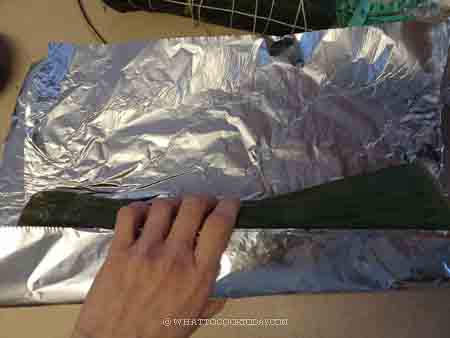
18. Lift up the banana leaf on both sides and then fold it over to enclose it. Roll it together with the foil to form a log. 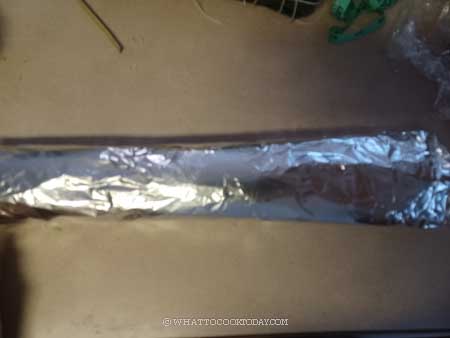
19. Bent the extra leaf and foil at the bottom as you position the log straight up. Fill up with one tablespoon of rice. Fold the leaf and foil over to secure. Repeat with the other side. The foil is strong enough to keep the log enclosed without having to tie any kitchen strings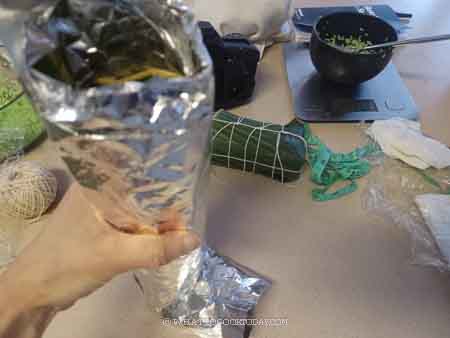
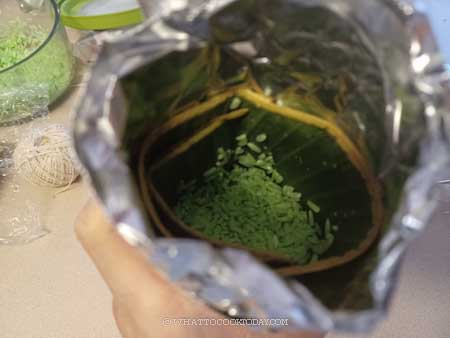
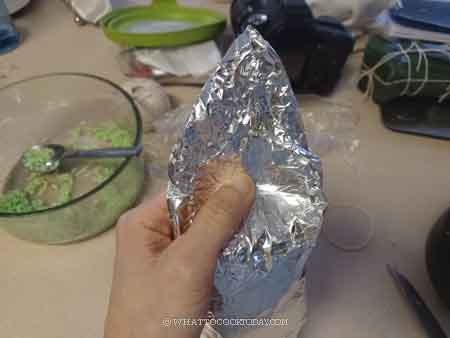
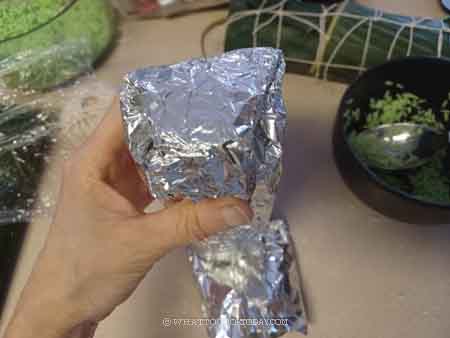
20. Repeat with the rest of the rice, filling, and wrappers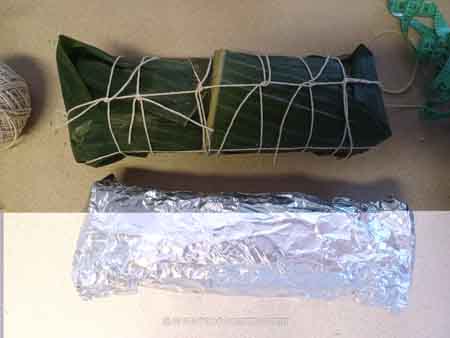
21. Place the banh tet inside the inner pot of the Instant Pot. Fill up with water up to the max line. Do not go over the maximum line. Close the lid. Turn the steam release valve to “sealing”. Press “pressure cooker” and set the timer to 2 hours (120 minutes) on high pressure. Release the pressure immediately after. If the log is too long and you have to position it in a diagonal position and the top part is not covered in water, that’s fine, you can set the timer to 1 hour and then release pressure and rotate the log to the other side and pressure cook again for another 1 hour.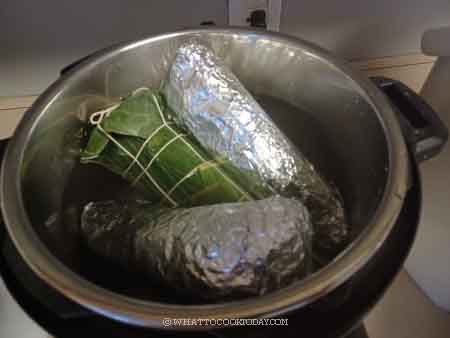
22. Carefully remove banh tet from the pot and put on a heat-proof colander. Rinse with cold water to stop the cooking process. The cakes still feel soft at this point. 

23. Put the banh tet as straight up as possible to drain off the liquid. I put them on a colander with a plate underneath to catch any draining liquid. Let them cool down overnight before cutting. Do not cut the cake when it’s still warm.
24. Unwrap the banana leaves and/or aluminum foil. I use dental floss to cut the cake. You can also use kitchen strings to cut it. These make a cleaner cut compared to using a knife. Cut the cake into about 3/4 inch thick slices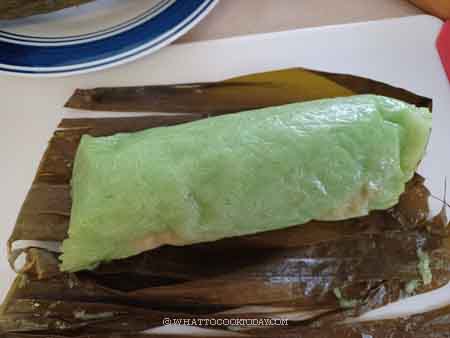
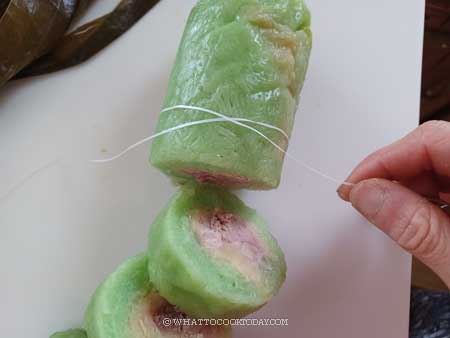
Other Banh-type recipes you may enjoy
Depending on the how it’s made, the ingredients, the origin, etc, it can be named as Banh (something..) such as Banh Bao (steamed buns), Banh Mi (Vietnamese baguette sandwich), Banh Xu Xe (Mung bean cake), Banh Pia (Mung bean pastry), Banh Tom (Shrimp and sweet potato fritters), Banh Xeo (Vietnamese crepes), Banh Beo (Steamed rice cake)

Banh Tet / Vietnamese Sticky Rice Cake (Instant Pot or Stove-Top)
Ingredients
- 500 g glutinous rice
- 50 g pandan leaves you can also use 1 tsp pandan essence
- 500 ml water
- 1 tsp salt
Mung bean filling:
- 150 gr split yellow mung bean
- 300 ml water
- ½ tsp salt
- 1 Tbsp sugar
Pork filling:
- 300 g pork belly or pork shoulder/butt
- ⅓ tsp salt
- 1 tsp sugar
- ½ tsp ground white pepper
- 2 tsp onion powder
For wrapping:
- Banana leaves
- aluminum foil
- Kitchen twine
Instructions
Things to prepare the day before:
Marinate the meat:
- Cut the meat into about 6 inches (15 cm) long strips. Add salt, sugar, and pepper and mix to make sure the meat are evenly marinated. I cover and leave this overnight in the fridge
Prepare pandan juice (if using):
- Cut pandan leaves into little pieces. Add this to the blender along with 500 ml water and blend until the pandan leaves are reduced to pulp. Strain the juice out as much as you can and discard the pulp
Soak the rice:
- Soak the rice in pandan juice for at least 4 hours or overnight. Drain off the liquid after that and add 1 tsp of salt and toss to combine
Cook the mung beans:
- Rinse the mung beans in clean water and then drain off water. Put mung beans with water in a pot and bring to a boil and then lower the heat to let it simmer until the beans are soft and water is reduced, about 20 minutes or so. You should be able to easily mash the beans. Add salt and sugar and mash the beans with a spoon. The mung beans may appear soft now, but it will harden later. Let it cool down completely at room temperature. If you are making this the day before, cover and store in the fridge
On the day you plan to cook:
- I suggest making about 6 of 6 inches long banh tet because they can fit into a 6-quart Instant Pot nicely. I made 3 of 8 inches banh tet and I have to rotate them during cooking because it's too long
- If the banana leaves are frozen, let them thaw and then soften the leaves by soaking in some warm water if the leaves are stiff
- For each log you will need one banana leaf about 10 x 10 inches (25 x 25 cm) and 2 pieces of aluminum foil, the same size. The banana leaf will impart a nice flavor to the sticky rice and the foils are to secure the log so the rice won't leak out during cooking
- You also need this for each log: 50 grams of meat, about 125 grams of rice, and about 65 grams of mung bean paste
Prepare the filling:
- Spread the mung bean paste on a cling wrap, about 6 inches in width. Place 50 grams of meat. Pull the cling wrap up to enclose the meat. Mold the bean paste around the meat to secure it into a log shape. Repeat with the rest of the meat and mung bean paste
Option 1: Wrapping (using all banana leaves):
- Traditional banh tet is wrapped using all banana leaves and kitchen strings and some rubber bands to help you get the job done.
- For each log you will need 3 banana leaves about 25 x 25 cm and 2 banana leaves, about 8 x 20 cm to cover both ends and some kitchen strings
- Place two sheets of banana leaves on top of each other, shiny side facing down. The the 3rd banana leaf, shiny side facing you. Spread half of the rice on the banana leaf. Place one filling in the middle. Top with more rice on top of the filling log. Leave about 2 tablespoons of rice to top up on each side later
- Lift up the banana leaf on both sides and then fold it over to enclose it. Roll it together with the other two banana leaves. Bent the extra leaves at the bottom as you position the log straight up. Use one rubber band to secure the lower bottom. Fill up with one tablespoon of rice. Fold the leaves over to secure. Cover with the long banana leaves ( 8 x 20 cm). Secure with a rubber band. Repeat with the other side.
- Remove the rubber bands and use a long kitchen string, three times the length of the banh tet to tie the log vertically
- Then use shorter strings to tie around the log to secure it so the leaves won't burst open during cooking. My wrapping and tying are not the most professional looking lol, but it works to secure the log
Option 2: Wrapping (with banana leaves + aluminum foil):
- Place two sheets of aluminum foil on top of each other, shiny side facing down. One banana leaf on top of the foil, shiny side facing you. Spread half of the rice on the banana leaf. Place one filling in the middle. Top with more rice on top of the filling log. Leave about 2 tablespoons of rice to top up on each side later
- Lift up the banana leaf on both sides and then fold it over to enclose it. Roll it together with the foil to form a log. Bent the extra leaf and foil at the bottom as you position the log straight up. Fill up with one tablespoon of rice. Fold the leaf and foil over to secure. Repeat with the other side. The foil is strong enough to keep the log enclosed without having to tie any kitchen strings
- Repeat with the rest of the rice, filling, and wrappers
Cooking on Instant Pot pressure cooker:
- Place the banh tet inside the inner pot of the Instant Pot. Fill up with water up to the max line. Do not go over the maximum line. Close the lid. Turn the steam release valve to "sealing"
- Press "pressure cooker" and set the timer to 2 hours (120 minutes) on high pressure. Release the pressure immediately after. If the log is too long and you have to position it in a diagonal position and the top part is not covered in water, that's fine, you can set the timer to 1 hour and then release pressure and rotate the log to the other side and pressure cook again for another 1 hour.
Cooking on the stove:
- You need a tall stock pot for the best result. Put the log inside the pot in a standing position. Fill up with water until it almost covers the log. The log may float so you want to place a plate on top to make sure they are submerged in the water. Bring the water to a boil and then lower the heat to simmer for the next 4 hours (yes..a long time). You will need to have some boiling water ready to top up the water. Do not top up with cold water as that will mess up the cooking process and the cakes will take even longer to cook
Cooling down:
- Carefully remove banh tet from the pot and put on a heat-proof colander. Rinse with cold water to stop the cooking process. The cakes still feel soft at this point. Put the banh tet as straight up as possible to drain off the liquid. I put them on a colander with a plate underneath to catch any draining liquid. Let them cool down overnight before cutting. Do not cut the cake when it's still warm.
- Don't let the banh tet cool down in a horizontal flat position as the water won't drain properly and this makes the banh tet soggy on one side
To serve:
- I use dental floss to cut the cake. You can also use kitchen strings to cut it. These make a cleaner cut compared to using a knife. Cut the cake into about 3/4 inch thick slices
Storage:
- You can store leftover banh tet in the fridge for about one week. The rice hardens when it's cold and that's normal. Simply reheat in a steamer over high heat for 5 minutes or reheat in the microwave until heated through
- For longer storage, once banh tet has cooled down completely, store them in a freezer bag, push all the air out and seal. They freeze really well for up to 3 months. Simply thaw in the fridge overnight before you plan to serve and reheat in the steamer over high heat for 5 minutes.


